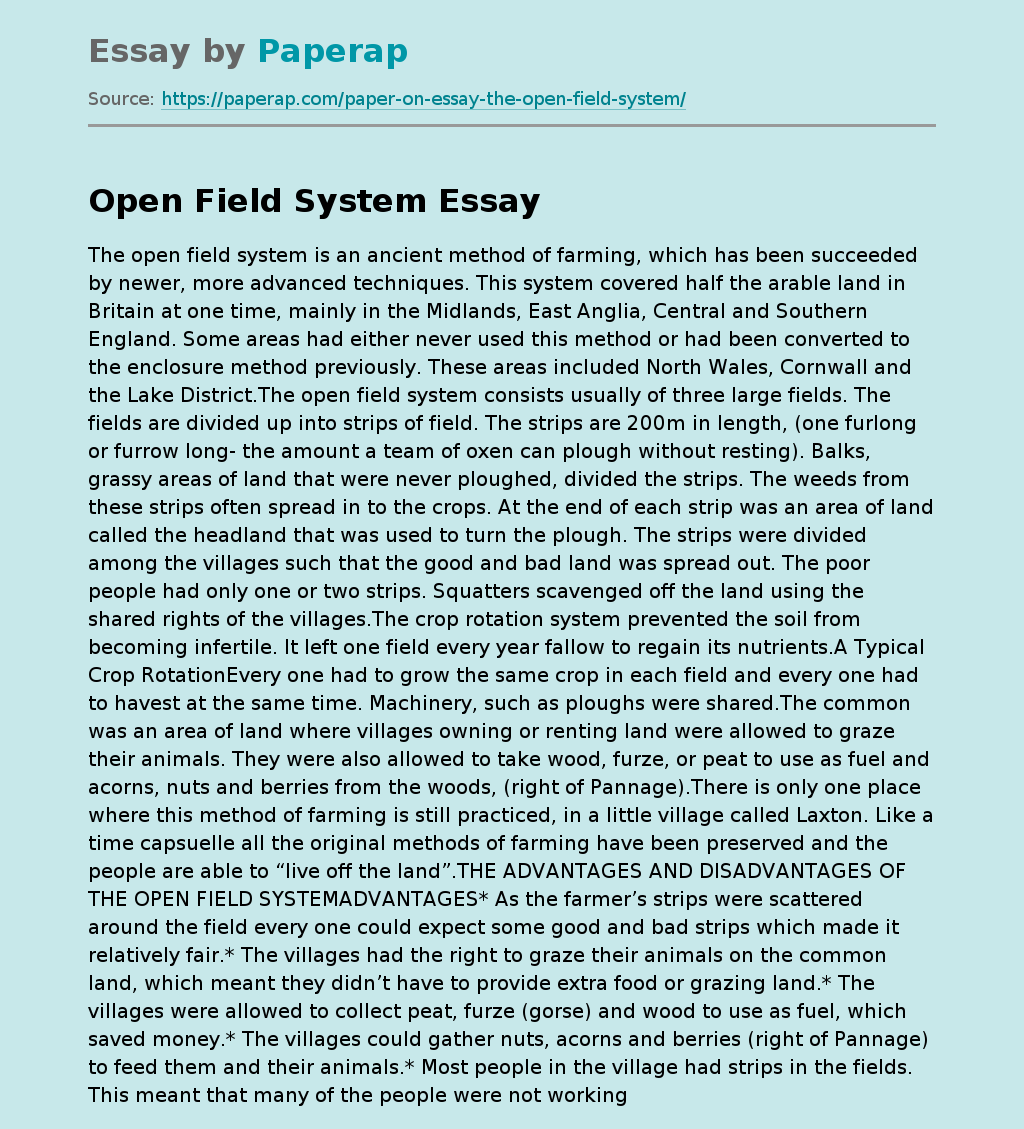Open Field System
The open field system is an ancient method of farming, which has been succeeded by newer, more advanced techniques. This system covered half the arable land in Britain at one time, mainly in the Midlands, East Anglia, Central and Southern England. Some areas had either never used this method or had been converted to the enclosure method previously. These areas included North Wales, Cornwall and the Lake District.The open field system consists usually of three large fields. The fields are divided up into strips of field.
The strips are 200m in length, (one furlong or furrow long- the amount a team of oxen can plough without resting). Balks, grassy areas of land that were never ploughed, divided the strips. The weeds from these strips often spread in to the crops. At the end of each strip was an area of land called the headland that was used to turn the plough. The strips were divided among the villages such that the good and bad land was spread out.
The poor people had only one or two strips. Squatters scavenged off the land using the shared rights of the villages.The crop rotation system prevented the soil from becoming infertile. It left one field every year fallow to regain its nutrients.A Typical Crop RotationEvery one had to grow the same crop in each field and every one had to havest at the same time. Machinery, such as ploughs were shared.The common was an area of land where villages owning or renting land were allowed to graze their animals.
They were also allowed to take wood, furze, or peat to use as fuel and acorns, nuts and berries from the woods, (right of Pannage).There is only one place where this method of farming is still practiced, in a little village called Laxton. Like a time capsuelle all the original methods of farming have been preserved and the people are able to “live off the land”.THE ADVANTAGES AND DISADVANTAGES OF THE OPEN FIELD SYSTEMADVANTAGES* As the farmer’s strips were scattered around the field every one could expect some good and bad strips which made it relatively fair.* The villages had the right to graze their animals on the common land, which meant they didn’t have to provide extra food or grazing land.* The villages were allowed to collect peat, furze (gorse) and wood to use as fuel, which saved money.* The villages could gather nuts, acorns and berries (right of Pannage) to feed them and their animals.* Most people in the village had strips in the fields. This meant that many of the people were not working as labourers for other people but farming their own land.* As the requirements of the open farming system were very simple all the needs of the villages were catered for in the village, e.g. the blacksmiths, carpenters and local tradesmen could make the tools.* The open field system meant that the villages were able to provide for themselves as they bred all their animals and grew all their own vegetables and grain. This was necessary, as there was not much trade between cities and villages.* The open field system benefited the poorest people in the village, as they were able to use the resources of the land, e.g. grazing their animals, gathering fuel.* The villages could share tools. This meant they didn’t have to buy expensive tools that many of the poorer people could not afford.* The open field system led to close knit communities since every one had to co-operate. Even so there were still disagreements and fights within this.DISADVANTAGES* Since all the animals grazed on the common there was no selective breeding leading to specialised animals. For example; animals bred for their meat, wool or size.* Farmer’s wasted time travelling between their strips, as they could often be quite a distance between each strip.* As the Farmer’s land was divided in very small strips there was no benefit in trying new technology or expensive new machinery such as the seed drill.* Not much food was grown for the animals so most were killed before the winter began so there was little point in stockbreeding.* Everyone had to grow the same crops, as otherwise the farming methods would be disturbed.* Balks separated the strips so the boundary could be determined and an area at the end of each strip had to be left for turning the plough. Neither of these areas was able to be farmed therefore wasting a substantial amount of land.* Since all the villages were growing the same crops if one plot became diseased it could spread and a whole crop could be lost.* Similarly if one farmer doesn’t look after his land then the weeds would take over and spread to the surrounding plots of land.* The common grazing land allowed diseased and healthy animals to be in contact and therefore disease could spread through everyone’s animals.* As there were no enclosures, such as walls and hedges, animals were able to stray from the common to the fields often destroying crops. This was a punishable offence but didn’t compensate for lose of crops.Although the Open Field System had survived for many years had satisfied the villagers, as new technologies and benefits of new techniques of farming emerged eventually the people wanted a change.
Open Field System. (2019, Dec 05). Retrieved from https://paperap.com/paper-on-essay-the-open-field-system/

